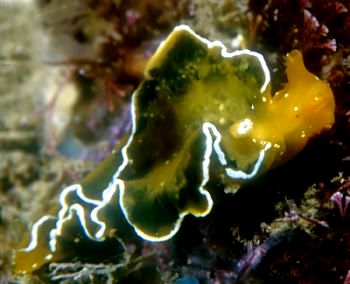
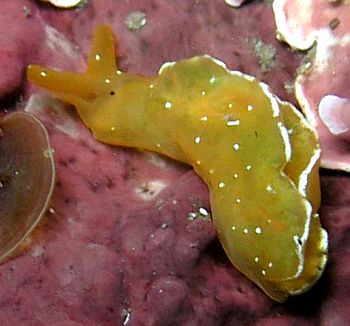
Elysia obtusa
Baba, 1938
Order: SACOGLOSSA
Superfamily: ELYSIOIDEA
Family: Elysiidae
DISTRIBUTION
Widespread western Pacific distribution from Japan & Hong Kong to eastern Australia.
PHOTO
UPPER: Tsim Chau, Hong Kong. 10m depth, length 1.5 cm. Photo: Leslie Chan.
LOWER: Echizen Beach, Fukui prefecture, West coast of Japan. 18th July, 2001. Depth: 5m Size: 10mm. Photo: Nishina Chikako.
Animal transucent yellow with white spots scattered over the body, head and parapodia. Edge of parapodia lined with bright white line. In sonme animals the green of the digestive gland causes the parapodia to be dark green in colour bbut from the range of photos in the Forum it appears that the green colouration is probably a temporary colouration dependent on how recently an animal has been feeding. Dark green parapodia probably corresponds to a recently fed animal while predominantly yellow animals have probably not fed for some time. Some authors have identifies this northwestern pacific species with the Carribbean E. flava, but until the antomy of the two are compared I would think such a synonymy is premature.
Eveline Marcus (1980) describes Elysia flava Verrill, 1901 are reported to be light yellow with white specks and faint dull brown markings on the head and neck. The parapodia are light green with a white edging and dendritic white branches extending in from the edge. The inner surface is almost black.
Reference:
• Baba, K (1938) Opisthobranchia of Kii, Middle Japan. J. Dept. Agric. Kyusyu Imp. Univ., 6(1): 1-19.
• Baba, K. (1949) Opisthobranchia of Sagami Bay collected by His Majesty The Emperor of Japan. Iwanami Shoyen, Tokyo. 194pp., 50 Pls.
• Carlson, C.H. & Hoff, P.J. (1978) The identifiable Elysia from Guam (Elysiidae, Sacoglossa, Opisthobranchia). Micronesica, 14: 89-113.
Rudman, W.B., 2001 (July 24) Elysia obtusa Baba, 1938. [In] Sea Slug Forum. Australian Museum, Sydney. Available from http://www.seaslugforum.net/find/elysobtu
Related messages
Elysia obtusa from India
January 20, 2010
From: Vishal Bhave
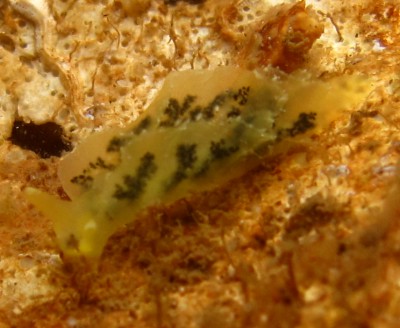
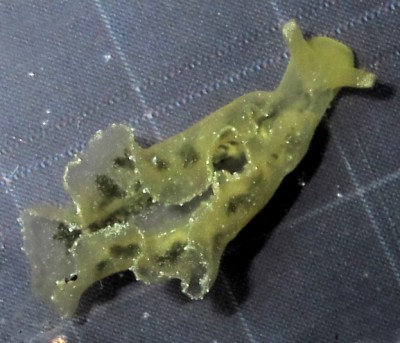
Here is Elysia obtusa. It was seen under oyster shell, in shallow rock pool.
Happy New year to all !
Locality: Mandavi, Ratnagiri, 20 centimetres, Maharashtra, India, Arabian sea, 29 December 2009, Intertidal, shallow rockpool. Length: 13 mm. Photographer: Vishal Bhave.
Vishal Bhave
vishalbhave@gmail.com
Bhave, V.J., 2010 (Jan 20) Elysia obtusa from India. [Message in] Sea Slug Forum. Australian Museum, Sydney. Available from http://www.seaslugforum.net/find/23047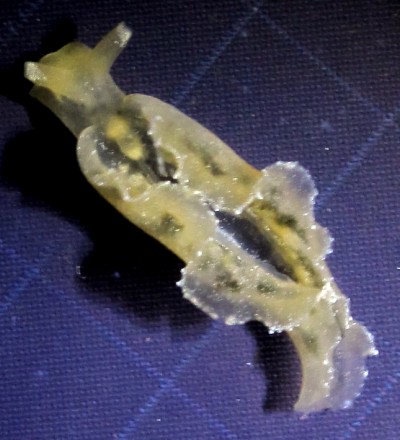
Dear Vishal,
Yes this is Elysia obtusa. At present it is known only from the western Pacific, so your find certainly adds it to those species which probably extend throughout the Indian Ocean as well.
Best wishes,
Bill Rudman
Elysia obtusa from Hawaii
June 22, 2006
From: Keoki Stender
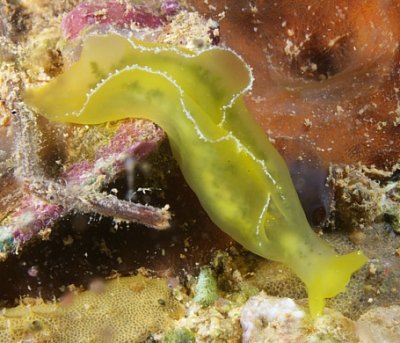
Concerning message #4935:
Hi Bill,
Here's what I think is the first record of Elysia obtusa from Hawaii. It looks a lot like Scott's specimen from the Marshall Islands. Found at night under a stone in two feet of water.
Locality: Moku O Loe (Coconut Is.), Kaneohe Bay, Oahu, 0.5m, Hawaii, USA, Central Pacific, 12 June 2006, Under stone on reef flat. Length: 20mm. Photographer: Keoki Stender.
Thanks,
Keoki Stender
fishpicshi@yahoo.com
Stender, K., 2006 (Jun 22) Elysia obtusa from Hawaii. [Message in] Sea Slug Forum. Australian Museum, Sydney. Available from http://www.seaslugforum.net/find/16931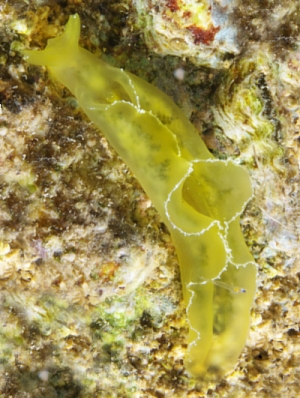
Dear Keoki,
I think you are right on both the indentification and the new record from Hawaii. Your photos show the transparency of the animal very well and the dark branching of the digestive gland.
Best wishes,
Bill Rudman
Elysia obtusa from South Korea
June 9, 2005
From: Dong Bum Koh
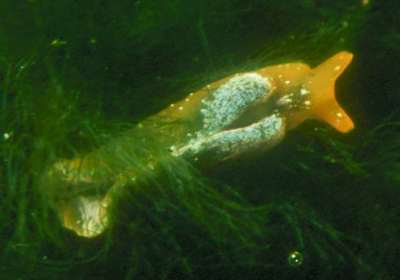
Dear Bill,
This is a photo of what I think is Elysia obtusa on green algae.
Locality: Moon islet. Jeju, Island, South Korea. Depth: 14 m. Length: 10 mm. 06 June. 2004. Rock Wall. Photographer: Dong Bum Koh
Best regards,
Dong Bum Koh
drkoh@seasee.co.kr
D. B. Koh, 2005 (Jun 9) Elysia obtusa from South Korea. [Message in] Sea Slug Forum. Australian Museum, Sydney. Available from http://www.seaslugforum.net/find/13964Thanks Koh,
It certainly fits the description of that species.
Best wishes,
Bill Rudman
Re: Development in Elysia obtusa
September 25, 2002
From: Jun Imamoto
Dear Kathe and Bill,
Thank you for your comments. Though my expectations were disappointed, I am pleased to learn something new by getting the specialist's opinion. I go to this tide pool frequently so I may be able to follow the growth of this animal. I will let you know if I am successful.
Best Regards,
Jun Imamoto
imamoto@wips.co.jp
Imamoto, J., 2002 (Sep 25) Re: Development in Elysia obtusa. [Message in] Sea Slug Forum. Australian Museum, Sydney. Available from http://www.seaslugforum.net/find/7989Re: Development in Elysia obtusa
September 16, 2002
From: Kathe Jensen
Dear Bill,
I think that the animal in the pictures is a damaged specimen in which the left parapodium has started to regenerate (no white pigment along the border), and the remains of the right parapodium is sort of hanging loose because most of the foot has been lost as well. There also seems to have been damage to the head. The rhinophores are missing, which could indicate a recently metamorphosed animal. However, the anteriormost part of the head also looks strange. It seems that the pedal lobes extend far beyond the head (and there seem to be 3?). Most Elysias are less than 1 mm when they metamorphose, and at that stage there is no trace of parapodia. The visceral mass uncoils when the shell is lost, but trails after the foot for maybe 2-3 days. Most Elysias have dark pigment on the "face" just after metamorphosis and very little of the adult
pigmentation. In this animal the yellow adult colour is prominent, and the white pigment on the border of the right parapodium and pericardium also points against this being a recently metamorphosed animal. Probably this animal has only survived because it has been in a protected tide-pool. Otherwise sacoglossans that have lost most of their foot cannot attach to the substrate very well and they are dislodged from their food algae very easily.
You can find drawings of postmetamorphic development in E. subornata [as Elysia "cauze"] and E. timida in the papers listed below.
References:
• Clark, K.B., Busacca, M. & Stirts, H. 1979. Nutritional aspects of development of the ascoglossan, Elysia cauze. In: Reproductive Ecology of Marine Invertebrates (S.E. Stancyk, ed.), pp. 11-24. Univ. S. Carol. Press, Columbia, SC.
• Marin, A. & Ros, J. 1993. Ultrastructural and ecological aspects of the development of chloroplast retention in the sacoglossan gastropod Elysia timida. Journal of Molluscan Studies, 59: 95-104.
Best wishes,
Kathe
jensen@ait.ac.th
Jensen, K., 2002 (Sep 16) Re: Development in Elysia obtusa. [Message in] Sea Slug Forum. Australian Museum, Sydney. Available from http://www.seaslugforum.net/find/7961Thanks Kathe,
Bill Rudman
Post-settlement juveniles of Elysia obtusa
September 14, 2002
From: Jun Imamoto
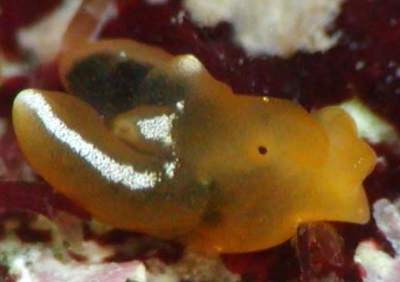
Dear Bill,
I found this sea slug in a tide pool at the beach. It was under a rock and it was very little. I think that obviously it is Elysia obtusa. But I think that its form is a little different from the adult. Perhaps it is stage in its development from a larva to an adult. Adults of E. obtusa are common on this beach.
Manazuru, Sagami Bay, Japan. Size approx 4mm, Intertidal., Temp: 26C, 8 Sep 2002.
Best Regards,
Jun Imamoto
http://umiushi.zive.net/
imamoto@wips.co.jp
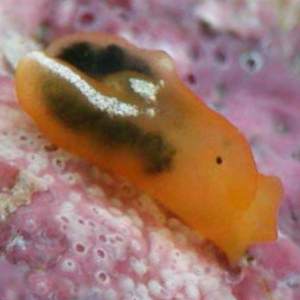
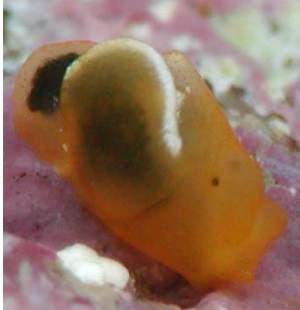
Dear Jun,
This is a very interesting discovery - I don't know how you could take such good photos of animals so small in a tide pool. I agree that these are most likely to be juvenile E. obtusa. I guess there is a possibility that this is a damaged animal, but if so the damage has been done in a very symmetrical way. If it is not damaged, it looks like the parapodia begin as flaps of tissue, perhaps mantle tissue, which then grow posteriorly, presumably to fuse with the foot. This is rather different from what you would expect to happen. A more usual scenario would be for the digestive gland to extend posteriorly and gradually grow up as parapodia on each side. I can't find any literature of larval development on these animals. Hopefully Kathe Jensen, Cynthia Trowbridge or Yoshi Hirano will have some ideas. As I said it could be a damaged animal, so one priority would be to try and find some more of these juveniles - not an easy task I would think.
Best wishes,
Bill Rudman
Habitat of Elysia obtusa
July 29, 2001
From: Nishina Masayoshi
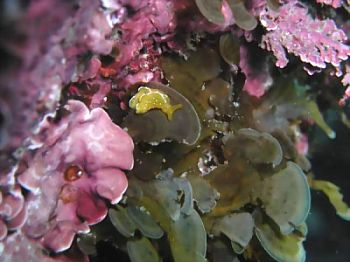
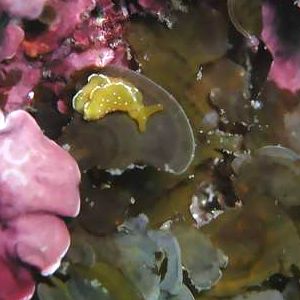
Dear Dr.Rudman,
I don't know whether E. obtusa hides under dead coral slabs or rocks during the day, as reported by Scott Johnson and Julie Marshall, because this is the first time I have found it.
I have attached an image showing where I found it. It was in the middle of a rock, 8m high, which rose almost perpendicularly in the water. As far as I remember there are no species of Bryopsis in Echizen Beach where I found it.
Best wishes,
Nishina
nishina@hpe15.wips.co.jp
Nishina, M., 2001 (Jul 29) Habitat of Elysia obtusa. [Message in] Sea Slug Forum. Australian Museum, Sydney. Available from http://www.seaslugforum.net/find/4955Dear Nishina,
Even if they do prefer being under coral slabs in some habitats, it does not necessarily mean they will always prefer such a place. It is certainly hard to be sure of an animal's requirements without a lot of investigation. That is why recording observations like yours, Scott's & Julie's are so valuable.
It is unlikely that your animal was feeding on the dictyotacean brown algae it is on. Perhaps there are small green algae growing on the larger brown alga, or perhaps Elysia was just crawling by.
Best wishes,
Bill Rudman
Elysia obtusa from the Marshall Ids
July 28, 2001
From: Scott Johnson
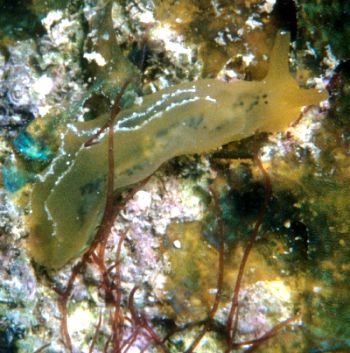
Hi Bill,
Elysia obtusa also occurs in the Marshall Islands, where I have found it in Enewetak, Bikini, and Kwajalein Atolls. I thought of this photo when Kathe mentioned Derbesia, but the brown filaments in the picture don't appear to me to be closely related to Bryopsis, so I presume it is something else. I do not recall seeing the Elysia eating this or any other algae. The animals here are generally found hidden away under rocks during the day.
Scott
johnson@kmr.ll.mit.edu
Johnson, S., 2001 (Jul 28) Elysia obtusa from the Marshall Ids. [Message in] Sea Slug Forum. Australian Museum, Sydney. Available from http://www.seaslugforum.net/find/4935Thanks Scott,
Your alga looks like a red to me. Your observation about it hiding under rocks during the day fits with Julie Marshall's observations.
Cheers,
Bill Rudman
Elysia obtusa and its diet
July 27, 2001
From: Kathe R. Jensen
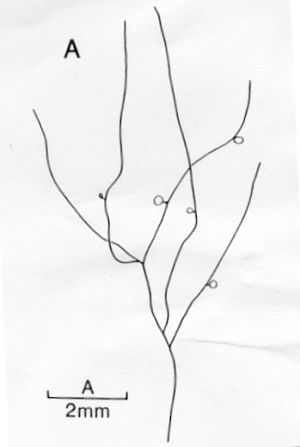
Dear Bill,
It was interesting to see that Cynthia found Elysia obtusa on Bryopsis. Like the other collectors, I have not found it associated with any particular algae (in fact, I have only collected 2 or 3 specimens in Hong Kong). Now that this species seems to be popping up a lot of places, it would be nice if someone would look for small (only a few cm long) filamentous algae, possibly with tiny bulbous structures (sporangia) attached to the sparsely branched filaments. This could be the algal genus Derbesia, which is very closely related to Bryopsis, and which can almost always be eaten by "Bryopsis -feeders". The interesting thing about this pair of algal genera is that in Bryopsis the gametophyte (which forms flagellated gametes) is the well-known, feather-like thallus, which has cell walls composed of xylan and cellulose. In Derbesia it is the sporophyte (forming diploid zoospores) which is the visible, filamentous thallus. The sporophyte cell walls are composed mainly of mannan. My theory is that the rate of speciation of sacoglossans increased, and their "adaptive radiation" to almost all siphonaceous green algae began when species feeding on filamentous Udoteacea (with xylan cell walls) switched diet to Bryopsis, and from Bryopsis either to Cladophorales (with cellulose cell walls) or to Derbesia and then to Codium (with mannan cell walls). Today few species have been recorded to feed only on Bryopsis and/or Derbesia, but many species feed on either Cladophorales plus Bryopsis or on Codium plus Bryopsis. A few, like Elysia viridis, can include the whole range of these algae.
So any more information on sacoglossans from Bryopsis and/or Derbesia would be most welcome. I would also greatly appreciate information on possible food algae of Elysia flava, from the Mediterranean, from the Canary Islands, from Bermuda or from the Caribbean.
The attached drawing of Derbesia is from Womersley, (1984). It just doen't look like much - and it is the same in the field.
Reference:
• Jensen, K.R. (1997) Evolution of the Sacoglossa (Mollusca, Opisthobranchia) and the ecological associations with their food plants. Evolutionary Ecology, 11: 301-335.
• Womersley, (1984). The Marine Benthic Flora of Southern Australia, Part I. (Fig. 100A, p. 291. Derbesia tenuissima).
Greetings,
Kathe
jensen@ait.ac.th
Jensen, K.R., 2001 (Jul 27) Elysia obtusa and its diet. [Message in] Sea Slug Forum. Australian Museum, Sydney. Available from http://www.seaslugforum.net/find/4925Thanks Kathe,
The relationship between herbivores and their plant foods is a fascinating field of study.
Best wishes,
Bill Rudman
Elysia obtusa from Heron Island
July 26, 2001
From: Julie Marshall
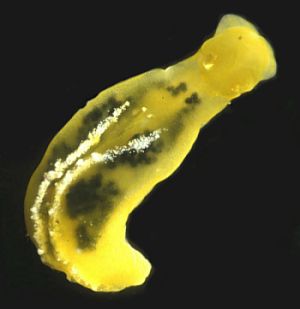
Dear Bill,
It was nice to see pictures up on the Forum for Elysia obtusa. It seems to have quite a wide distribution in the southern as well as the northwestern Pacific as it is known from northern NSW and from several sites in Queensland, including Heron Island. We record 20 records of this species in our book on Heron Island opisthobranchs, most ranging from 6 to 8 mm in size. Attached are some photos from Heron Island. In two of the photos the green of the digestive gland in the yellow animal is clearly visible. I always find Elysia obtusa under dead coral slabs at the reef crest at low tide.
Best wishes,
Julie Marshall
j.marshall@latrobe.edu.au
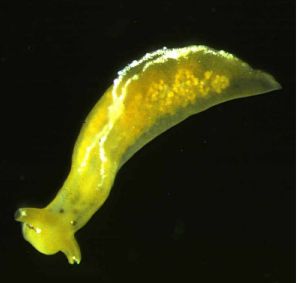
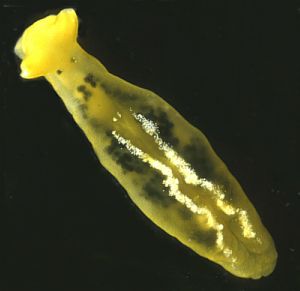
Thanks Julie,
I should have mentioned your Heron Island records. They do indeed give it a wide distribution, at least in the western Pacific.
Best wishes,
Bill Rudman
Another photo of Elysia obtusa
July 26, 2001
From: Nishina Masayoshi
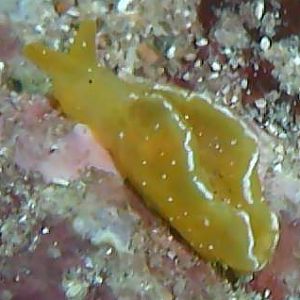
Dear Dr.Rudman,
It's very good for me to know me about the relation between feeding cycle and body color. Here is a better photo to see the inner surface.
Best Regards,
Nishina Masayoshi
nishina@hpe15.wips.co.jp
Nishina, M., 2001 (Jul 26) Another photo of Elysia obtusa. [Message in] Sea Slug Forum. Australian Museum, Sydney. Available from http://www.seaslugforum.net/find/4920Dear Nishina,
Thanks again. I guess you have seen the page on colour in sea slugs which discusses some of the functions colour has in these animals. For example, the cerata of many aeolids changes colour depending on the colour of the food they are eating - a very good example being the egg-eating species of the genus Favorinus.
Best wishes,
Bill Rudman
Re: Elysia obtusa from Japan
July 26, 2001
From: Cynthia Trowbridge
Dear Bill,
What a coincidence: I just found this same sacoglossan species yesterday on a very small species of intertidal Bryopsis in Sagami Bay, here in Japan. The animal is bright orange, particularly the head. Perhaps Bryopsis chloroplasts are not as stable as Codium and Caulerpa chloroplasts when inside sacoglossans. As you say, the green chlorophyll breaks down into orange degradation products; it would be very neat if someone would calibrate the color change with slug starvation, under different light conditions, for this species. I did so for Placida dendritica in Oregon but I am not sure how general the results are in estimating the time since last feeding for other sacoglossans. This would be an interesting student project.
Cordially,
Cynthia
trowbric@ucs.orst.edu
Trowbridge, C., 2001 (Jul 26) Re: Elysia obtusa from Japan. [Message in] Sea Slug Forum. Australian Museum, Sydney. Available from http://www.seaslugforum.net/find/4923Dear Cynthia,
This shy retiring little sacoglossan has certainly generated some interest. Six messages in 2 days. There are certainly lots of interesting projects for students but I find that the only problem with opisthobranchs is that you can't guarantee that the ones you want are going to be available when you need them. I am glad to hear your Japanese visit is obviously being very productive.
Best wishes,
Bill Rudman
Elysia obtusa from Japan
July 25, 2001
From: Nishina Masayoshi & Chikako

Dear Dr.Rudman,
I found this animal at Echizen, Japan. I think this is may be Elysia flava.
I think this species is not common here or at Hachijo or Sagami Bay.
These photos are all of the same animal. It was found on the pink encrusting coralline algae and we moved it temporarily to photograph it on the algae in the bottom right photo.
Data: Echizen beach (Fukui prefecture, Russian side of Japan), 18th July, 2001
Depth: 5m. Water temp. 25C degree. Size: 10mm
Photo by Chikako.
Best Regards,
Nishina Masayoshi & Chikako
nishina@hpe15.wips.co.jp
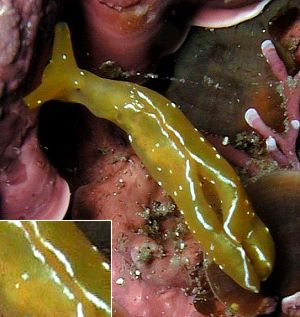
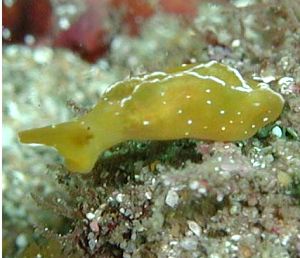
Dear Nishina & Chikako,
Thank you for these very interesting photos of Elysia obtusa which arrived just as I was preparing to post some messages about this animal from Hong Kong. Your animal with only a little tinge of green is good to compare with the much greener animals from Hong Kong. As I discuss at the top of the page, there is a yellow species of Elysia, Elysia flava Verrill, 1901, described from the Caribbean, but until the anatomy of that species is compared with E. obtusa it is not possible to discuss whether or not they are the same species.
Best wishes,
Bill Rudman
Elysia obtusa from Hong Kong.
July 25, 2001
From: Leslie Chan

Dear Dr.Rudman
Here is another Elysia from Hong Kong which I photographd this year.
Details: Tsim Chau, Hong Kong. 10m depth, length 1.5 cm.
I hope it is of interest.
Cheers,
Leslie.
leslie@lesmart.com
Chan, L., 2001 (Jul 25) Elysia obtusa from Hong Kong.. [Message in] Sea Slug Forum. Australian Museum, Sydney. Available from http://www.seaslugforum.net/find/4912Thanks Leslie,
This is another interesting species, Elysia obtusa, which we know little about. Your photo, showing the opened parapodia, clearly show that the dark green colour is associated with the branching of the digestive gland. Have a look at the photos of animals from Japan which are much yellower. I suspect they represent a stage in the feeding cycle where the animals have almost completely digested the green plant tissue in their digestive system.
Best wishes,
Bill Rudman
Elysia obtusa from Hong Kong
July 25, 2001
From: Bill Rudman & Brian Darvell
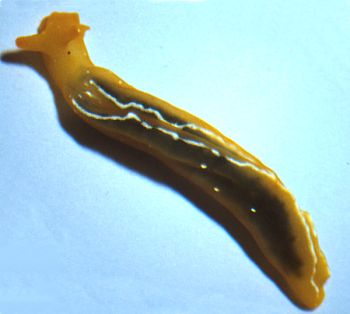
To accompany Leslie Chan's photo, here is the single record of Elysia obtusa from Brian Darvell's Hong Kong collections.
PHOTO:Kong Chau, Hong Kong, 6 March 1983, Photo: B. Darvell. AM C138151 HK57/1,
Best wishes,
Bill Rudman & Brian Darvell
